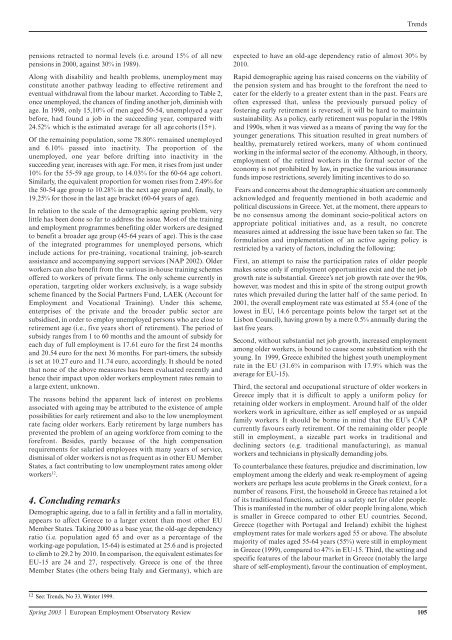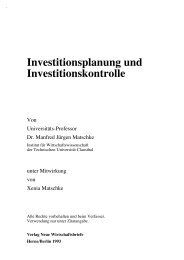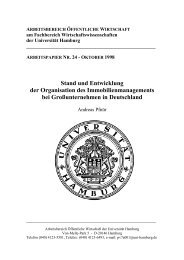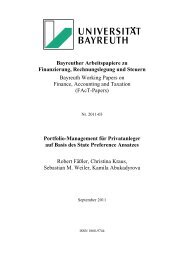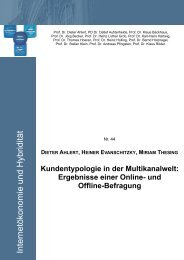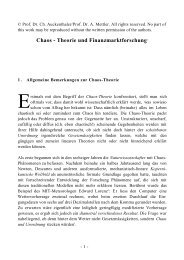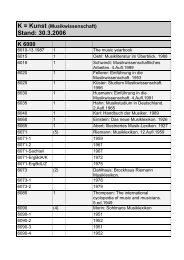FRANCE The
FRANCE The
FRANCE The
You also want an ePaper? Increase the reach of your titles
YUMPU automatically turns print PDFs into web optimized ePapers that Google loves.
pensions retracted to normal levels (i.e. around 15% of all new<br />
pensions in 2000, against 30% in 1989).<br />
Along with disability and health problems, unemployment may<br />
constitute another pathway leading to effective retirement and<br />
eventual withdrawal from the labour market. According to Table 2,<br />
once unemployed, the chances of finding another job, diminish with<br />
age. In 1998, only 15,10% of men aged 50-54, unemployed a year<br />
before, had found a job in the succeeding year, compared with<br />
24.52% which is the estimated average for all age cohorts (15+).<br />
Of the remaining population, some 78.80% remained unemployed<br />
and 6.10% passed into inactivity. <strong>The</strong> proportion of the<br />
unemployed, one year before drifting into inactivity in the<br />
succeeding year, increases with age. For men, it rises from just under<br />
10% for the 55-59 age group, to 14.03% for the 60-64 age cohort.<br />
Similarly, the equivalent proportion for women rises from 2.49% for<br />
the 50-54 age group to 10.28% in the next age group and, finally, to<br />
19.25% for those in the last age bracket (60-64 years of age).<br />
In relation to the scale of the demographic ageing problem, very<br />
little has been done so far to address the issue. Most of the training<br />
and employment programmes benefiting older workers are designed<br />
to benefit a broader age group (45-64 years of age). This is the case<br />
of the integrated programmes for unemployed persons, which<br />
include actions for pre-training, vocational training, job-search<br />
assistance and accompanying support services (NAP 2002). Older<br />
workers can also benefit from the various in-house training schemes<br />
offered to workers of private firms. <strong>The</strong> only scheme currently in<br />
operation, targeting older workers exclusively, is a wage subsidy<br />
scheme financed by the Social Partners Fund, LAEK (Account for<br />
Employment and Vocational Training). Under this scheme,<br />
enterprises of the private and the broader public sector are<br />
subsidised, in order to employ unemployed persons who are close to<br />
retirement age (i.e., five years short of retirement). <strong>The</strong> period of<br />
subsidy ranges from 1 to 60 months and the amount of subsidy for<br />
each day of full employment is 17.61 euro for the first 24 months<br />
and 20.54 euro for the next 36 months. For part-timers, the subsidy<br />
is set at 10.27 euro and 11.74 euro, accordingly. It should be noted<br />
that none of the above measures has been evaluated recently and<br />
hence their impact upon older workers employment rates remain to<br />
a large extent, unknown.<br />
<strong>The</strong> reasons behind the apparent lack of interest on problems<br />
associated with ageing may be attributed to the existence of ample<br />
possibilities for early retirement and also to the low unemployment<br />
rate facing older workers. Early retirement by large numbers has<br />
prevented the problem of an ageing workforce from coming to the<br />
forefront. Besides, partly because of the high compensation<br />
requirements for salaried employees with many years of service,<br />
dismissal of older workers is not as frequent as in other EU Member<br />
States, a fact contributing to low unemployment rates among older<br />
workers12 .<br />
4. Concluding remarks<br />
Demographic ageing, due to a fall in fertility and a fall in mortality,<br />
appears to affect Greece to a larger extent than most other EU<br />
Member States. Taking 2000 as a base year, the old-age dependency<br />
ratio (i.e. population aged 65 and over as a percentage of the<br />
working-age population, 15-64) is estimated at 25.6 and is projected<br />
to climb to 29.2 by 2010. In comparison, the equivalent estimates for<br />
EU-15 are 24 and 27, respectively. Greece is one of the three<br />
Member States (the others being Italy and Germany), which are<br />
12 See: Trends, No 33, Winter 1999.<br />
Spring 2003 | European Employment Observatory Review 105<br />
Trends<br />
expected to have an old-age dependency ratio of almost 30% by<br />
2010.<br />
Rapid demographic ageing has raised concerns on the viability of<br />
the pension system and has brought to the forefront the need to<br />
cater for the elderly to a greater extent than in the past. Fears are<br />
often expressed that, unless the previously pursued policy of<br />
fostering early retirement is reversed, it will be hard to maintain<br />
sustainability. As a policy, early retirement was popular in the 1980s<br />
and 1990s, when it was viewed as a means of paving the way for the<br />
younger generations. This situation resulted in great numbers of<br />
healthy, prematurely retired workers, many of whom continued<br />
working in the informal sector of the economy. Although, in theory,<br />
employment of the retired workers in the formal sector of the<br />
economy is not prohibited by law, in practice the various insurance<br />
funds impose restrictions, severely limiting incentives to do so.<br />
Fears and concerns about the demographic situation are commonly<br />
acknowledged and frequently mentioned in both academic and<br />
political discussions in Greece. Yet, at the moment, there appears to<br />
be no consensus among the dominant socio-political actors on<br />
appropriate political initiatives and, as a result, no concrete<br />
measures aimed at addressing the issue have been taken so far. <strong>The</strong><br />
formulation and implementation of an active ageing policy is<br />
restricted by a variety of factors, including the following:<br />
First, an attempt to raise the participation rates of older people<br />
makes sense only if employment opportunities exist and the net job<br />
growth rate is substantial. Greece’s net job growth rate over the 90s,<br />
however, was modest and this in spite of the strong output growth<br />
rates which prevailed during the latter half of the same period. In<br />
2001, the overall employment rate was estimated at 55.4 (one of the<br />
lowest in EU, 14.6 percentage points below the target set at the<br />
Lisbon Council), having grown by a mere 0.5% annually during the<br />
last five years.<br />
Second, without substantial net job growth, increased employment<br />
among older workers, is bound to cause some substitution with the<br />
young. In 1999, Greece exhibited the highest youth unemployment<br />
rate in the EU (31.6% in comparison with 17.9% which was the<br />
average for EU-15).<br />
Third, the sectoral and occupational structure of older workers in<br />
Greece imply that it is difficult to apply a uniform policy for<br />
retaining older workers in employment. Around half of the older<br />
workers work in agriculture, either as self employed or as unpaid<br />
family workers. It should be borne in mind that the EU’s CAP<br />
currently favours early retirement. Of the remaining older people<br />
still in employment, a sizeable part works in traditional and<br />
declining sectors (e.g. traditional manufacturing), as manual<br />
workers and technicians in physically demanding jobs.<br />
To counterbalance these features, prejudice and discrimination, low<br />
employment among the elderly and weak re-employment of ageing<br />
workers are perhaps less acute problems in the Greek context, for a<br />
number of reasons. First, the household in Greece has retained a lot<br />
of its traditional functions, acting as a safety net for older people.<br />
This is manifested in the number of older people living alone, which<br />
is smaller in Greece compared to other EU countries. Second,<br />
Greece (together with Portugal and Ireland) exhibit the highest<br />
employment rates for male workers aged 55 or above. <strong>The</strong> absolute<br />
majority of males aged 55-64 years (55%) were still in employment<br />
in Greece (1999), compared to 47% in EU-15. Third, the setting and<br />
specific features of the labour market in Greece (notably the large<br />
share of self-employment), favour the continuation of employment,


